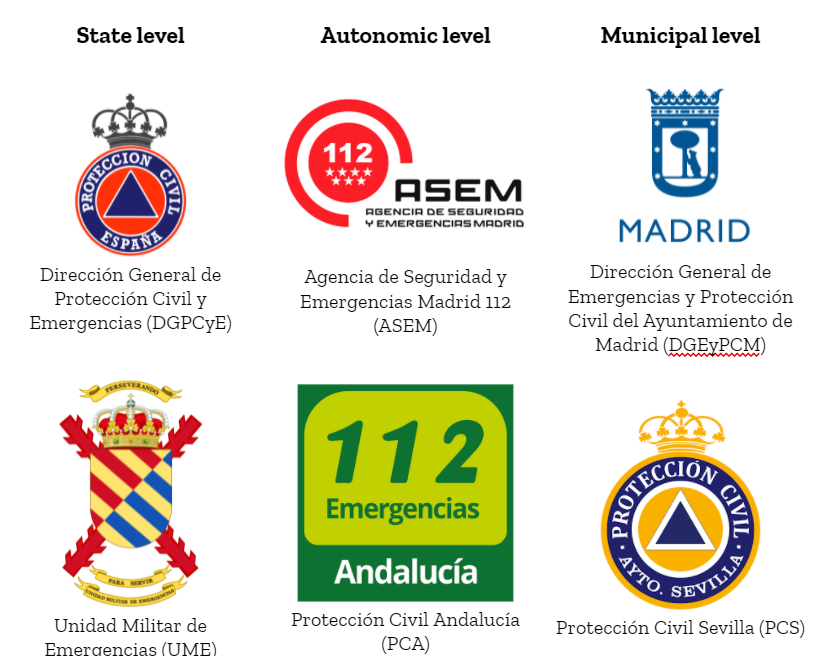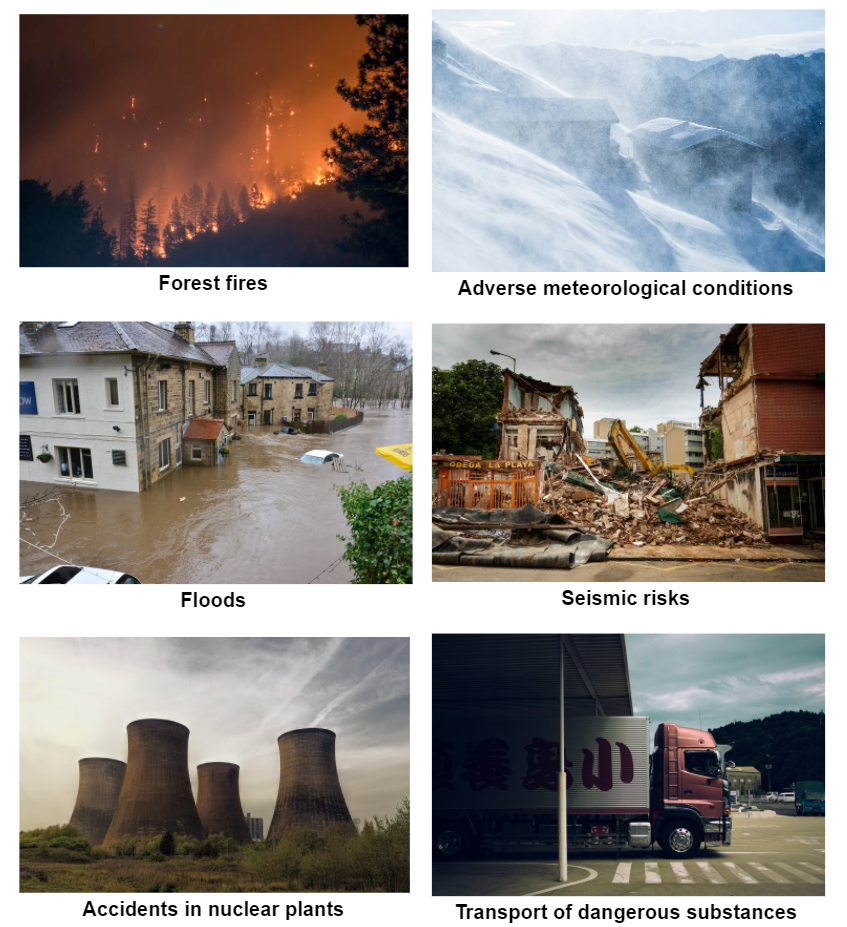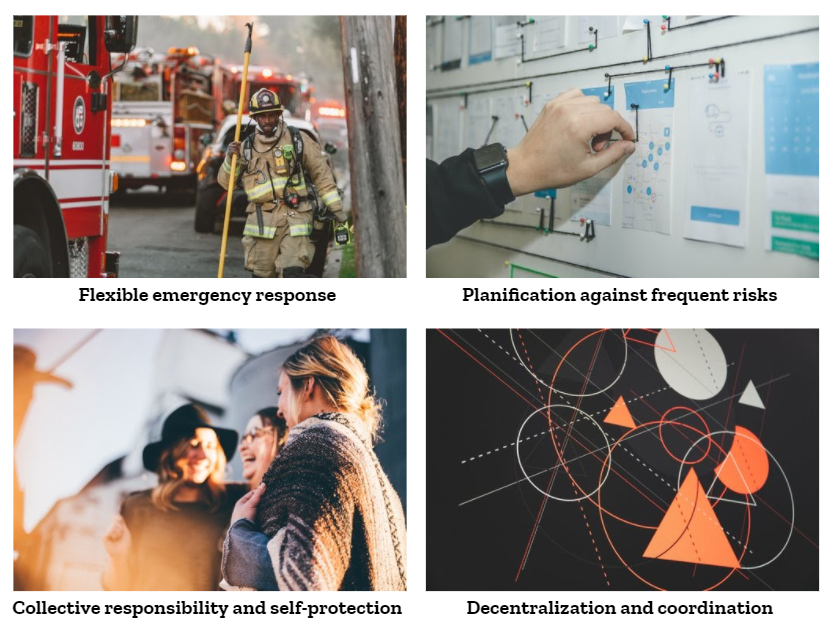Takeaways from our interviews of Spanish Civil Protection servants
By Jaime Sevilla, JuanGarcia, Ángela Aristizábal @ 2021-11-24T09:12 (+37)
As part of a strategy to create a link between the global GCR community and Spanish civil servants, we (Jaime Sevilla, Juan García and Ángela María Aristizábal) have interviewed the directors of six public risk management organizations in Spain. All of them belong to the Sistema Nacional de Protección Civil (National Civil Protection System), which is coordinated by the Ministerio del Interior (Ministry of the Interior). See the organizations we interviewed below in table 1.
The National Civil Protection System is a service designed to protect people and material goods during emergencies and catastrophes.

We have published an investigative report (in Spanish) about this topic in our Riesgos Catastroficos Globales’ webpage.
In this article we translate some core insights. We hope this will help other people looking into risk governance by providing an example of how public risk is managed at the national level in one particular country. We also want to provide an example (and get feedback) on ways in which new researchers can engage in risk management policy by first creating a diagnosis of governmental responses to emergencies and mapping the institutions that play important roles in risk management. While we have checked with civil protection servants to help us correct mistakes, we are not experts in law nor civil protection, so take these insights with a grain of salt.
First, we will cover how the Spanish National Civil Protection System works:
- The Civil Protection System is designed to respond to emergencies in a flexible and timely way. This is implemented through the coordination of emergency groups: in the case of an emergency, the corresponding civil protection organization assembles a team of experts and representatives from public and private services relevant to the emergency (e.g. firefighters during forest fires, or healthcare professionals and representatives of funeral homes during a pandemic). For the duration of the emergency, the team periodically meets to follow up on the situation and discuss next steps. This process was formalized in the State’s General Emergency Plan (PLEGEM).
The core function of the civil protection system is therefore to coordinate teams of area specialists during emergencies.
- It is split into a three-level hierarchy. On top of the hierarchy there is a state-level actor (DGPCyE), with access to some military resources (UME). Below them there is one coordinator organization for each of the Spanish autonomies. Finally, each municipality with a population over twenty thousand citizens is required to have its own civil protection team.
The state-level organization regulates the process of creation of autonomic and municipal plans. This ensures a common format and language across regions in matters of civil protection.
- There are Civil Protection emergency plans dedicated to some specific risks. The risks that are mandatorily included in the plans are declared by law. The rationale behind what risks are included in the law is not (to us) immediately evident. They include a mix of risks that are historically frequent (like forest fires or floods), risks where there has been historical precedent of risk management (like nuclear plant or aviation accidents) and risks to which the territory is exposed and/or vulnerable but whose most recent precedent is hundreds of years in the past(like tsunamis). A modification to the current list of risks that civil protection services mandatorily needs to prepare for would require passing a new law.
Beyond the planning for specific risks required by law, the autonomic and municipal civil protection organizations have the jurisdiction to make local plans covering other risks. For example, Andalucia’s civil protection plan includes a section dedicated to the environmental protection of the coast.
Table 2 includes a relation of some representative risks the Spanish National Civil Protection System is actively planning for.

- There is a cemented notion of collective responsibility when responding to emergencies, codified in the law of self-protection. Every center, establishment and annex dedicated to an activity that could give rise to an emergency is required to submit a self-protection plan to their local Civil Protection authority, detailing the possible risks that may happen and their plans for dealing with them (fire hazards and evacuation plans, for the most part). Every citizen also has an obligation to care for themselves and their properties, and to manage risks in their surroundings.
To a lesser extent, the different Civil Protection organizations engage in some prevention activities for the planned risks, especially around forest fire prevention.
Our impression is that these four concepts are core to how the civil protection service operates.

Here there are some other insights from our interviews. Note that these correspond to our personal impressions, rather than to hard facts.
- Civil Protection in Spain seems greatly influenced by risk management abroad. Some civil servants we interviewed studied abroad in specialized schools, and there is a shared perception that many plans are done in response to what is being done elsewhere, like the implementation of a tsunami response plan.
- The whole civil protection system seems to have strong roots in the firefighting services. Many people we have interviewed had a history of working as firefighters, and in general fire hazard prevention and management is a central piece of all civil protection institutions.
- There is a widespread resilience mentality among civil protection specialists, and a general sense that “you need to plan for the unforeseen”. The general response plans are intended to work regardless of the nature of the emergency that triggers them. The flip side is that there is little work being done in risk foresight. One notable exception is the elaboration of historical maps of incidents for some of the risks (example).
- In general civil protection servants have a clear desire to improve the current civil protection system. The people involved are pushing for improving the current plans, and to incorporate new technologies like mobile area broadcasts and drones in their emergency response plans.
- We found the civil servants very open to collaboration. Our interviews were generally well received. During the project we were invited to collaborate with the City Council of Madrid in their project to update their municipal emergency plan.
This project was an initial effort to map some of the actors involved in risk management at the national level in Spain. We are trying to create a link between the global GCR community and Spanish civil servants working in disaster preparedness.
If you are interested in improving risk management public policy in Spanish-speaking countries, please reach out to us. Also reach out if you want to discuss this or related topics!
Jsevillamol @ 2021-11-29T10:18 (+6)
I have received a private comment asking about the role of civil protection during COVID.
This is what I answered:
About COVID, we asked everyone about their role on it.
Basically the picture I got is: public health is delegated to the ministry of health, and in particular pandemics are seen as the business of the Centre of Sanitary Alerts (CCAES) The CCAES does have an early warning system, but we could not talk to them and we don't know how the systems reacted to COVID.
In the civil prot side, they basically did nothing until the govn declared an alarm state. It is not clear if the activation was urged by the CCAES, civil protection or if it came from up top. After the alarm state was declared, civil prot organized decentralised committees at the state, autonomy and municipal level to monitor the situation and discuss next steps. These committees incorporated public health experts, civil prot servants and other public and private figures with relevant expertise.
The military "forces" under command of civil protection (the UME) were mobilized, but they lacked expertise on dealing with pandemics and basically were ordered to help disinfect hospitals and other public places, even after it became obvious that the pandemic was airborne and that disinfecting helped little.
In general I think that the civil prot response was good and prompt once they were ordered to act. In particular, I think the decentralised response involving several expertise was as good as could have been given their lack of preparation.
But they weren't able to anticipate and react to early signs and their own forces were unprepared for a pandemic. It would also have helped to have mapped out in advance who were relevant experts to consult at every level of the system
Denkenberger @ 2021-11-26T23:17 (+5)
Very interesting! Could you say how open you think they are to planning for global catastrophic risks?
Jsevillamol @ 2021-11-29T14:23 (+6)
(disclaimer: this is my opinion)
In short: Spanish civil protection would not as of today consider making plans to address specific GCRs
There is this weird tension where they believe that resilience is very important, and that planning in advance is nearly useless for non-recurring risks.
The civil protection system is very geared towards response. Foresight, mitigation and prevention seldom happens.This means they are quite keen on improving their general response capacity but they have no patience for hypotheticals. So they would not consider specific GCRs.
Even if they wanted to address GCRs, their hands are relatively tied (at least at the national level) - the risks they do specific preparation for are encoded in the law and modifying the list of priority risks would require passing an amendment.
In their opinion some things like geomagnetic storms which could theoretically unleash a global catastrophe are to be addressed by the generalist response plans. And, at least one high ranked person thinks a specific plan for responding to solar storms and similar risks is could be created, but not without a coordinated technical and policy response at the European level.
On the other hand we have seen some autonomies that have enacted their own special civil protection plans independently, but for minor risks (eg coastal environmental protection).And for example Madrid's city hall wants to have better maps of which expertise is needed and where to find it for conceivable future emergencies.
Also bear in mind that while civil protection is a very important part of risk management in Spain, it is not the only part. The national security system and other organizations might have different attitudes towards GCRs.